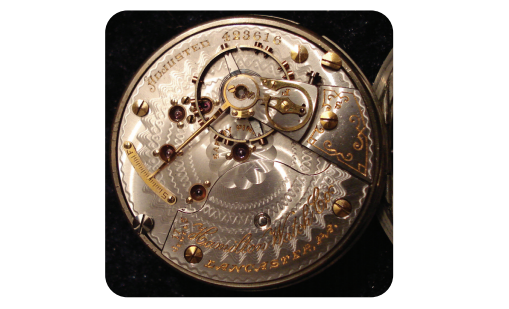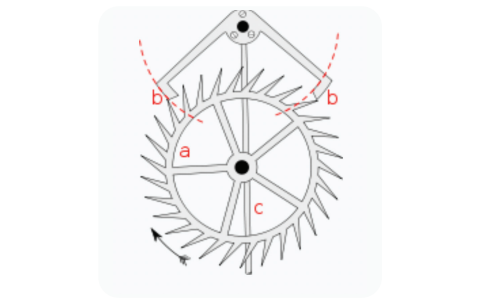MTime Measurement by Clock
Time measuring devices are generally called clocks. The Slovak term “hodiny” comes from the Old Slavic word goch, which means holiday, anniversary. Throughout human history, clocks have been created on numerous physical principles, with varying accuracy and application. Accurate clocks are important not only for measuring time, but also for determining the position of ships and aircraft in maritime and air transport, for example. That is why the discovery of clocks for sea voyages, or currently the GPS (Global Positioning System) or other similar systems, was so important in the history of mankind.
Sundial
Of particular importance is the sundial, which, unlike other types of clocks, measures the apparent solar time at a given point on the Earth's surface. The sundial can be divided according to the shape and position of the indicator, whose shadow on the scale shows the time. We distinguish between sundials with a half-axis, a rod pointing in the direction of the Earth's axis, and sundials with a gnomon, rod or rod perpendicular to the Earth's surface in a given place. We can also distinguish sundials according to other aspects, for example according to location, or according to the orientation of the wall on which they are placed, according to other functional elements or according to the graphic form. Some sundials are equipped with a node, a small ball at the end of the indicator, which allows you to determine not only the hour on the clock, but also the approximate day of the year. Other sundials have a double scale, showing both Central European Time and Central European Summer Time. An analemma at a certain hour, most often at 12 o'clock, or even a larger number of these curves can also be marked on the scale.
Clock Types
Other clocks can be divided into two unequally large groups: clocks that measure certain time intervals and clocks that measure and show the appropriate (zone) time.
The first group includes, for example:
• hourglass clocks, which have their typical shape and which measure the time (interval) needed to pour fine sand from one part of the vessel into another;
• water clock (klepsydra), which measures the time interval required to pour a given volume of water, the time is indicated by a decrease in the level of liquid in a transparent container;
• candle clock, which, unlike the previous types, was usable only once and which measured time according to the length of the burnt part of the candle;
• stopwatch designed for accurate time measurement, for example in sports races.
The second type is a clock, which is set to show the valid time in a given place, i. e. to allow you to find out what time it is. A hand clock has an hour and a minute hand, sometimes a second hand, and the time is read on a scale that is usually divided into 12 hours. A digital clock then shows the time in digital form.
Very roughly, such clocks can be divided into the following groups according to their drive and design:
• mechanical clock, which is characterised by a mechanical oscillator (a set of bodies with a suitable natural frequency of oscillations), mechanical gears (a set of gears and other components), a mechanical power source (spring, formerly weights) and a hand indication of time on the scale. The group of mechanical clocks includes tower clocks, pendulum clocks, portable clocks with a balance wheel, or nautical and aviation chronometers, but they can also be clocks or watches with an electric power source (electric cell) and with other attributes of mechanical clocks;
• electronic clock with an oscillator usually formed by quartz crystal;
• atomic clocks, which measure time using the resonant frequency of certain atoms.
Composition of Mechanical Clocks
Mechanical clocks consist of several main parts. One of them is drive, a source of energy, which can be a weight gradually decreasing in the Earth's gravity field, a spring wound into a spiral, which is stretched by man and it then gradually transfers the accumulated energy to other parts, or an electric galvanic cell. The energy from the source is gradually transferred to other parts of the clock, using a system of gears or wheels, which we call a transmission. An oscillator is a key part of the clock that affects the accuracy of its operation. The most common types of oscillators are foliot, pendulum and balance wheel. The foliot is formed by an arm with two symmetrically placed weights, which rotates on a rope or belt around a vertical axis, and by twisting the rope a directional force momentum is created. The position of the weights on the arms determines the natural frequency of the foliot. The advantage of the pendulum as a clock oscillator is a time-stable frequency, the disadvantage is, in addition to attenuation, a small oscillation of the pendulum and the dependence of frequency on temperature (change of temperature causes change in length and different frequency), which was compensated for higher quality clocks. A balance wheel is used as an oscillator in portable clocks and watches. It is a wheel on a shaft, where the directional moment is induced by a hair made of a special alloy (invar), which has the shape of a spiral spring.

Pocket watch balance wheel
(Source: https://commons.wikimedia.org/wiki/File:Hamilton_926_movement.jpg)
Between the transmission and the oscillator there is a step, a component, the ends of which gradually fit into the toothing of the last gear wheel, and thus divide the uniform rotation into equally long sections. With each oscillator oscillation, one tooth of the wheel passes a step and at the same time supplies energy to the oscillator.

Graham Escapement
(Source: https://commons.wikimedia.org/wiki/File:Graham_Escapement.svg)
A natural part of a mechanical clock is a display device, especially a dial and hands. For some mechanical clocks, we also find other parts, such as a drum machine, a playing machine, a calendar machine, or a device that demonstrates the position of the Sun, the Moon. Although the accuracy of mechanical clocks did not reach the accuracy of sidereal time clocks until the beginning of the 20th century, their use was extraordinary. Some other mechanical clocks have their own special names, such as watches (small portable clocks, usually wristwatches), stopwatches, chronometers (high precision clocks), astronomical clocks, blind clocks with tactile indication of time, chess clocks (special double clocks allowing to measure time consumption separately, the time of both players), etc.
Composition of Electronic Clocks
The electronic clock is based on the oscillation of a quartz crystal due to a piezoelectric effect. The oscillations of the quartz crystal, which is machined into the shape of a tuner with the aid of a laser, are very stable, so that an electronic clock is at least one order of magnitude more accurate than a mechanical clock. The oscillator operates at a very high frequency of 32,768 Hz (32,768 = 215). The time display is no longer limited to the digital format, there is usually a watch with a hand display and nowadays practically other than electronic watches are no longer produced. A special type of electronic clock is a radio clock, which instead of its own oscillator usually has a miniature radio receiver and obtains data on the exact time using a long-wave time signal. In Europe, the DCF77 signal transmitted from Mainflingen, Germany, near Frankfurt am Main, is used.
Composition of Atomic Clocks
An atomic clock measures time using the resonant frequency of atoms, such as cesium or rubidium. The basis of the cesium atomic clock is a crystal oscillator, the frequency of which is electronically controlled. The oscillator is connected to a transmitter of radio waves emitted into a vessel with cesium atoms. When the frequency of the oscillator (and thus of the transmitter) coincides with the natural resonant frequency of the cesium atoms, they go into an excited state. According to the number of excited cesium atoms, it is possible to tune the frequency of the crystal oscillator to match the resonant frequency of the cesium atoms, i. e. 9.192,631,770 GHz. A strontium-based optical clock using quantum phenomena is in the research phase, for which the Nobel Prizes in Physics were awarded in 2005 and 2012. The relative accuracy of these modern clocks reaches 10-18.

(Source:https://upload.wikimedia.org/wikipedia/commons/thumb/d/de/Clock_accuracy.svg/220px-Clock_accuracy.svg.png)


